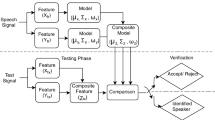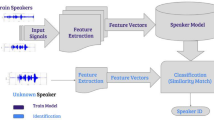Abstract
In this work we develop a speaker recognition system based on the excitation source information and demonstrate its significance by comparing with the vocal tract information based system. The speaker-specific excitation information is extracted by the subsegmental, segmental and suprasegmental processing of the LP residual. The speaker-specific information from each level is modeled independently using Gaussian mixture modeling—universal background model (GMM-UBM) modeling and then combined at the score level. The significance of the proposed speaker recognition system is demonstrated by conducting speaker verification experiments on the NIST-03 database. Two different tests, namely, Clean test and Noisy test are conducted. In case of Clean test, the test speech signal is used as it is for verification. In case of Noisy test, the test speech is corrupted by factory noise (9 dB) and then used for verification. Even though for Clean test case, the proposed source based speaker recognition system still provides relatively poor performance than the vocal tract information, its performance is better for Noisy test case. Finally, for both clean and noisy cases, by providing different and robust speaker-specific evidences, the proposed system helps the vocal tract system to further improve the overall performance.








Similar content being viewed by others
References
Ananthapadmanabha, T. V., & Yegnanarayana, B. (1979). Epoch extraction from linear prediction residual for identification of closed glottis interval. IEEE Transactions on Acoustics, Speech, and Signal Processing, ASSP-27, 309–319.
Atal, B. S. (1974). Effectiveness of linear prediction characteristics of the speech wave for automatic speaker identification and verification. The Journal of the Acoustical Society of America, 55(6), 1304–1312.
Atal, B. S. (1976). Automatic recognition of speakers from their voices. Proceedings of the IEEE, 64(4), 460–475.
Campbell, J. P. Jr. (1997). Speaker recognition: a tutorial. Proceedings of the IEEE, 85(9), 1437–1462.
Chan, W. N., Zheng, N., & Lee, T. (2007). Discrimination power of vocal source and vocal tract related features for speaker segmentations. IEEE Transactions on Audio, Speech and Signal Processing, 15(6), 1884–1892.
Davis, S. B., & Mermelstein, P. (1980). Comparison of parametric representations for monosyllabic word recognition in continuously spoken sentences. IEEE Transactions on Acoustics, Speech, and Signal Processing, 28(28), 357–366.
Deller, J. R. Jr., Hansen, J. H. L., & Proakis, J. G. (2000). Discrete-Time Processing of Speech Signal (2nd edn.). New York: IEEE Press.
Falk, T. H., & Chan, W.-Y. (2010). Modulation spectral features for robust far-field speaker identification. IEEE Transactions on Audio, Speech, and Language Processing, 18(1), 90–100.
Furui, S. (1981). Cepstral analysis technique for automatic speaker verification. IEEE Transactions on Acoustics, Speech, and Signal Processing, 29(2), 254–272.
Gish, H., & Schmidt, M. (1994). Text- independent speaker identification. IEEE Signal Processing Magazine, 11, 18–32.
Hall, J. J., & Srihari, S. N. (1994). Decision combination in multiple classifier systems. IEEE Transactions on Pattern Analysis and Machine Intelligence, 16, 66–75.
Hayakawa, S., Takeda, K., & Itakura, F. (1997). Speaker identification using harmonic structure of lp-residual spectrum. In Lecture notes: Vol. 1206. Biometric personal Authentification (pp. 253–260). Berlin: Springer.
Iseli, M. R., & Alwan, A. (2000). Inter- and intra-speaker variability of glottal flow derivative. In Int. conf. on spoken language processing (ICSLP, 2000), Beijing, China.
Kinnunen, T., & Li, H. (2009). An overview of text-independent speaker recognition: from features to supervectors. Speech Communication, 52, 12–40.
Kittler, J., Hatef, M., Duin, R. P. W., & Matas, J. (1998). On combining classifiers. IEEE Transactions on Pattern Analysis and Machine Intelligence, 20(3), 226–239.
Linguistic Data Consortium (2004). Switchboard cellular part 2 audio. http://www.ldc.upenn.edu/Catalog/CatalogEntry.jsp?catalogId=LDC2004S07.
Makhoul, J. (1975). Linear prediction: a tutorial review. Proceedings of the IEEE, 63(4), 561–580.
Martin, A., Doddington, G., Kamm, T., Ordowski, M., & Przybocki, M. (1997). The DET curve in assessment of detection task performance. In Proc. Eur. conf. on speech communication technology, Rhodes, Greece (Vol. 4, pp. 1895–1898).
Mary, L., & Yegnanarayana, B. (2008). Extraction and representation of prosodic features for language and speaker recognition. Speech Communication, 50, 782–796.
Mashao, D. J., & Skosan, M. (2006). Combining classifier decisions for robust speaker identification. Pattern Recognition, 39, 147–155.
Murthy, K. S. R., & Yegnanarayana, B. (2008). Epoch extraction from speech signal. IEEE Transactions on Audio, Speech, and Language Processing, 16(8), 1602–1613.
Murty, K. S. R., & Yegnanarayana, B. (2006). Combining evidence from residual phase and MFCC features for speaker recognition. IEEE Signal Processing Letters, 13(1), 52–55.
Murty, K. S. R., Prasanna, S. R. M., & Yegnanarayana, B. (2004). Speaker specific information from residual phase. In Int. conf. on signal proces. and comm. (SPCOM).
Naylor, P. A., Kounoudes, A., Gudnason, J., & Brookes, M. (2007). Estimation of glottal closure instants in voiced speech using the dypsa algorithm. IEEE Transactions on Audio, Speech, and Language Processing, 15(1), 34–43.
Nist speaker recognition evaluation plan (2003). In Proc. NIST speaker recognition workshop, College Park, MD.
Padmanabhan, R., & Murthy, H. A. (2010). Acoustic feature diversity and speaker verification. In INTERSPEECH 2010, Sept., Makuhari, Chiba, Japan (pp. 2010–2013).
Pati, D., & Prasanna, S. R. M. (2008). Non-parametric vector quantization of excitation source information for speaker recognition. In Proc. IEEE TENCON, 2008 (pp. 1–4).
Pati, D., & Prasanna, S. R. M. (2010). Speaker information from subband energies of linear prediction residual. In Proc. NCC 2010 (pp. 1–4).
Pati, D., & Prasanna, S. R. M. (2011a). Subsegmental, segmental and suprasegmental processing of linear prediction residual for speaker information. International Journal of Speech Technology, 14(1), 49–63.
Pati, D., & Prasanna, S. R. M. (2011b, accepted). Speaker recognition using suprasegmental level excitation information. International Journal of Information and Communication Technology (IJICT).
Pati, D., & Prasanna, S. R. M. (2012a, in press). Processing of linear prediction residual in spectral and cepstral domains for speaker information. In Communicated to SADHANA (Springer).
Pati, D., & Prasanna, S. R. M. (2012b, in press). A comparative study of explicit and implicit modeling of subsegmental speaker-specific excitation source information. In Communicated to SADHANA (Springer).
Plumpe, M. D., Quatieri, T. F., & Reynolds, D. A. (1999). Modelling of glottal flow derivative waveform with application to speaker identification. IEEE Transactions on Speech and Audio Processing, 7(5), 569–586.
Prasanna, S. R. M., Gupta, C. S., & Yegnanarayana, B. (2006). Extraction of speaker-specific excitation information from linear prediction residual of speech. Speech Communication, 48, 1243–1261.
Rabiner, L. R., & Schafer, R. W. (1978). Digital processing of speech signals. Englewood Cliffs: Prentice-Hall.
Reynolds, D. A. (1994). Experimental evaluation of features for robust speaker identification. IEEE Transactions on Speech and Audio Processing, 2(4), 639–643.
Reynolds, D. A. (1995). Speaker identification and verification using Gaussian mixture speaker models. Speech Communication, 17, 91–108.
Reynolds, D. A., & Rose, R. C. (1995a). Robust text-independent speaker identification using Gaussian mixture speaker models. IEEE Transactions on Speech and Audio Processing, 3(1), 72–83.
Reynolds, D. A., & Rose, R. C. (1995b). Robust text-independent speaker identification using Gaussian mixture speaker models. IEEE Transactions on Speech and Audio Processing, 3(1), 4–17.
Reynolds, D. A., Quatieri, T. F., & Dunn, R. (2000). Speaker verification using adapted Gaussian mixture models. Digital Signal Processing, 10, 19–41.
Thevenaz, P., & Hugli, H. (1995). Usefulness of the LPC-residue in text-independent speaker verification. Speech Communication, 17, 145–157.
Veldhuish, R. (1998). A computationally efficient alternative for the Liljencrants-Fant model and its perceptual evaluation. The Journal of the Acoustical Society of America, 103(1), 566–571.
Wang, N., Ching, P. C., & Lee, T. (2009). Exploration of vocal excitation modulation features for speaker recognition. In Proc. INTERSPEECH-09, Brighton, UK (pp. 892–895).
Xu, L., Krzyzak, A., & Suen, C. Y. (1992). Methods of combining multiple classifiers and their applications to handwriting. IEEE Transactions on Systems, Man, and Cybernetics, 22(3), 412–435.
Yegnanarayana, B., & Veldhuis, R. N. J. (1998). Extraction of vocal-tract system characteristics from speech signals. IEEE Transactions on Speech and Audio Processing, 6(4), 313–327.
Yegnanarayana, B., Reddy, K. S., & Kishore, S. P. (2001). Source and systsem feature for speaker recognition using AANN Models. In Proc. IEEE int. con. acoust. speech and signal process, Salt Lake City, UT, USA, May (pp. 409–412).
Yegnenarayana, B., & Murthy, K. S. R. (2009). Event based instantaneous fundamental frequency estimation from speech signals. IEEE Transactions on Audio, Speech, and Language Processing, 17(4), 614–624.
Zheng, N., Lee, T., & Ching, P. C. (2007). Integration of complimentary acoustic features for speaker recognition. IEEE Signal Processing Letters, 14(3), 181–184.
Author information
Authors and Affiliations
Corresponding author
Rights and permissions
About this article
Cite this article
Pati, D., Mahadeva Prasanna, S.R. Speaker verification using excitation source information. Int J Speech Technol 15, 241–257 (2012). https://doi.org/10.1007/s10772-012-9137-5
Received:
Accepted:
Published:
Issue Date:
DOI: https://doi.org/10.1007/s10772-012-9137-5




